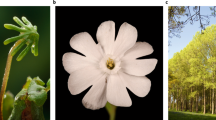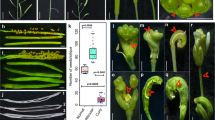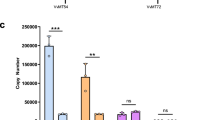Abstract
Although there have been many molecular studies of morphological mutants generated in the laboratory, it is unclear how these are related to mutants in natural populations, where the constraints of natural selection and breeding structure are quite different. Here we characterize a naturally occurring mutant of Linaria vulgaris, originally described more than 250 years ago by Linnaeus1,2,3, in which the fundamental symmetry of the flower is changed from bilateral to radial. We show that the mutant carries a defect in Lcyc, a homologue of the cycloidea gene which controls dorsoventral asymmetry in Antirrhinum4. The Lcyc gene is extensively methylated and transcriptionally silent in the mutant. This modification is heritable and co-segregates with the mutant phenotype. Occasionally the mutant reverts phenotypically during somatic development, correlating with demethylation of Lcyc and restoration of gene expression. It is surprising that the first natural morphological mutant to be characterized should trace to methylation, given the rarity of this mutational mechanism in the laboratory. This indicates that epigenetic mutations may play a more significant role in evolution than has hitherto been suspected.
This is a preview of subscription content, access via your institution
Access options
Subscribe to this journal
Receive 51 print issues and online access
$199.00 per year
only $3.90 per issue
Buy this article
- Purchase on Springer Link
- Instant access to full article PDF
Prices may be subject to local taxes which are calculated during checkout





Similar content being viewed by others
References
Linnaeus,C. De Peloria (Diss. Ac. Amoenitates Academicae III, Uppsala, 1749).
Gustafsson,A. Linnaeus' peloria: the history of a monster. Theor. Appl. Genet. 54, 241–248 (1979).
De Vries,H. in Species and Varieties: Their Origin by Mutations 459–487 (Open Court, Chicago, 1904).
Luo,D. et al. Origin of floral asymmetry in Antirrhinum. Nature 383, 794–799 (1996).
Almeida,J., Rocheta,M. & Galego,L. Genetic control of flower shape in Antirrhinum majus. Development 124, 1387–1392 (1997).
Das,O. P. & Messing,J. Variegated phenotype and developmental changes of a maize allele originating from epimutation. Genetics 136, 1121–1141 (1994).
Jacobsen,S. E. & Meyerowitz,E. M. Hypermethylated SUPERMAN epigenetic alleles in Arabidopsis. Science 277, 1100–1103 (1997).
Counts,J. L. & Goodman,J. I. Alterations in DNA methylation may play a variety of roles in carcinogenesis. Cell 83, 13–15 (1995).
Jones,P. A. & Laird,P. W. Cancer epigenetics comes of age. Nature Genet. 21, 163–167 (1999).
Docherty,Z. Self-incompatibility in Linaria. Heredity 49, 349–352 (1982).
Cambareri,E. B., Jensen,B. C., Schabtach,E. & Selker,E. U. Repeat-induced G-C to A-T mutations in Neurospora. Science 244, 1571–1575 (1989).
Hsieh, C.-L. & Lieber,M. R. CpG methylated minichromosomes become inaccessible for V(D)J recombination after undergoing replication. EMBO J. 11, 315–325 (1992).
Jablonka,E. & Lamb,M. J. Epigenetic variation in evolution. J. Evol. Biol. 11, 159–183 (1997).
Jablonka,E. & Lamb,M. J. The inheritance of acquired epigenetic variations. J. Theor. Biol. 139, 69–83 (1989).
Williams,M. H. & Green,P. B. Sequencial scanning electron microscopy of a growing plant meristem. Protoplasma 147, 77–79 (1988).
Brieger,F. G. The inheritance of self-sterility and the peloric flower shape in Antirrhinum. Genetics 17, 385–408 (1935).
Sherman,M. The inheritance of self-sterility in certain species of Antirrhinum. Z. Indukt Abstammungs-Verebunst 77, 1–17 (1939).
Bradley,D. et al. Complementary floral homeotic phenotypes result from opposite orientations of a transposon at the plena locus of Antirrhinum. Cell 72, 85–95 (1993).
Gubler,U. A one tube reaction for the synthesis of blunt-ended double-stranded cDNA. Nucleic Acids Res. 16, 2726 (1988).
Frohman,M. A., Dush,M. K. & Martin,G. R. Rapid production of full-length cDNAs from rare transcripts: amplification using a single gene-specific oligonucleotide primer. Proc. Natl Acad. Sci. USA 85, 8998–9002 (1988).
Cubas,P., Lauter,N., Doebley,J. & Coen,E. The TCP domain: a motif found in proteins regulating plant growth and development. Plant J. 18, 215–222 (1999).
Coen,E. et al. Floricaula: a homeotic gene required for flower development in Antirrhinum majus. Cell 63, 1311–1322 (1990).
Carpenter,R. et al. Control of flower development and phyllotaxy by meristem identity genes in Antirrhinum. The Plant Cell 7, 2001–2011 (1995).
Bradley,D. et al. Control of inflorescence architecture in Antirrhinum. Nature 379, 791–797 (1996).
Acknowledgements
We thank the Linnean Society of London for permission to photograph the specimen of peloric Linaria kept in Linnaeus' herbarium and thank C. Jarvis from the Natural History Museum in London for providing the photograph; we also thank M. Cragg-Barber for providing a living peloric specimen from the UK; N. Hartley for sequencing the genomic Lcyc region; D. Bradley for the Lcentroradialis probe; C. Martin for the Antirrhinum ubiquitin probe; and R. Carpenter, D. Bradley, O. Ratcliffe, I. Amaya and U. Nath for comments on the manuscript. This work was supported by the Gatsby Charitable Foundation. P.C. was an EMBO postdoctoral fellow and a EU postdoctoral fellow.
Author information
Authors and Affiliations
Corresponding author
Rights and permissions
About this article
Cite this article
Cubas, P., Vincent, C. & Coen, E. An epigenetic mutation responsible for natural variation in floral symmetry. Nature 401, 157–161 (1999). https://doi.org/10.1038/43657
Received:
Accepted:
Issue Date:
DOI: https://doi.org/10.1038/43657
This article is cited by
-
Genome-wide methylome stability and parental effects in the worldwide distributed Lombardy poplar
BMC Biology (2024)
-
Epigenetics: Toward improving crop disease resistance and agronomic characteristics
Plant Biotechnology Reports (2024)
-
Molecular mechanisms regulating ornamental traits and scent production in snapdragon (Antirrhinum majus L.)
Horticulture Advances (2023)
-
Regulation of plant epigenetic memory in response to cold and heat stress: towards climate resilient agriculture
Functional & Integrative Genomics (2023)
-
DNA demethylation affects imprinted gene expression in maize endosperm
Genome Biology (2022)
Comments
By submitting a comment you agree to abide by our Terms and Community Guidelines. If you find something abusive or that does not comply with our terms or guidelines please flag it as inappropriate.



